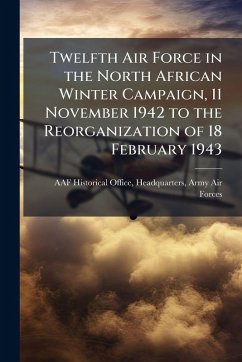
Physiological Problems of Bomber Crews in the Eighth Air Force During WWII
Versandkostenfrei!
Versandfertig in über 4 Wochen
14,99 €
inkl. MwSt.
Weitere Ausgaben:

PAYBACK Punkte
7 °P sammeln!
Aviation physiology is a highly relevant field to flyers of unpressurized aircraft that flew at altitudes in excess of 25,000 feet. Crew members had to contend with severe environmental factors while flying long bombing missions during WWII. The limits of human physiology must be the main concern of any battle plan involving flyers and fatality/mortality rates should be the primary focus in evaluating the success or failure of such a plan. The purpose of this research project is to determine if human factors were overlooked intentionally or by accident. If they were overlooked unintentionally,...
Aviation physiology is a highly relevant field to flyers of unpressurized aircraft that flew at altitudes in excess of 25,000 feet. Crew members had to contend with severe environmental factors while flying long bombing missions during WWII. The limits of human physiology must be the main concern of any battle plan involving flyers and fatality/mortality rates should be the primary focus in evaluating the success or failure of such a plan. The purpose of this research project is to determine if human factors were overlooked intentionally or by accident. If they were overlooked unintentionally, then what was done to resolve the physiological problems of the aircrews? The project will also underscore the continued need to address the human machine during any plan in today's demanding aviation environment. This work has been selected by scholars as being culturally important, and is part of the knowledge base of civilization as we know it. This work was reproduced from the original artifact, and remains as true to the original work as possible. Therefore, you will see the original copyright references, library stamps (as most of these works have been housed in our most important libraries around the world), and other notations in the work. This work is in the public domain in the United States of America, and possibly other nations. Within the United States, you may freely copy and distribute this work, as no entity (individual or corporate) has a copyright on the body of the work. As a reproduction of a historical artifact, this work may contain missing or blurred pages, poor pictures, errant marks, etc. Scholars believe, and we concur, that this work is important enough to be preserved, reproduced, and made generally available to the public. We appreciate your support of the preservation process, and thank you for being an important part of keeping this knowledge alive and relevant.












